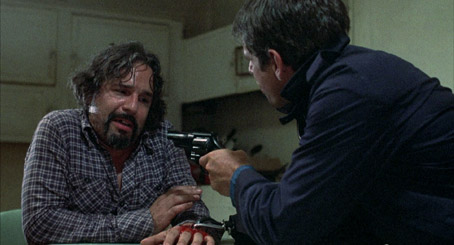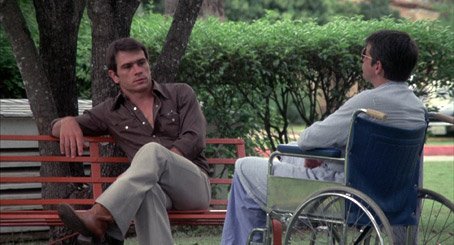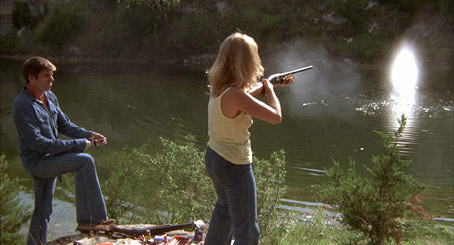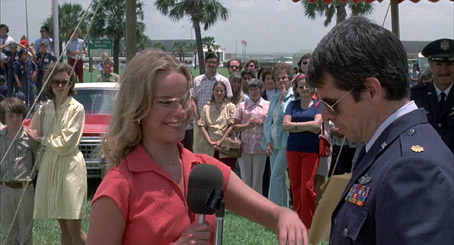"I wish we had something more exciting to shoot at." |
Linda, following some gun practice with Rane |
Candy: "What the fuck are you doing?" |
Johnny: "I'm gonna kill a bunch of people."
|
There are spoilers ahead, so proceed with caution.
I know I've said this before, but there's a curious dichotomy to the enjoyment of revenge movies, one that requires even the most liberal viewer to temporarily put their humanitarianism and belief in due process on hold and embrace a way of thinking that borders on the fascistic. In revenge movies justice is not delivered by society or the courts – who are frequently portrayed as siding with the criminal – but by the wronged individual, and often in a manner that sees the line between murderous sociopath and avenging vigilante blurred to near invisibility. Revenge movies toss aside centuries of civilisation and tap into a primal instinct to protect the nest and re-establish the injured party's alpha male standing. It's a trait that still re-surfaces in pubs across the land on Saturday nights, as alcohol unlocks the caveman within and prompts lugheads to mark their territory by threatening or delivering violence to just about anyone for anything, from accidentally bumping into them to looking sideways at their girlfriends. Piss someone like this off and he'll enact his own revenge movie on you, whatever the cost to his future or freedom.
It's usually men who feature in revenge movies, both as initial transgressor and eventual avenger, a primal warrior and protector who acts out of a combined sense of Old Testament justice and wounded pride. And in order for justice to be seen to be done, the retribution will often be disproportionate to the crime that first triggered it. Thus if someone murders your brother, you will be expected to kill not just them but their friends as well, and ideally you should torture a few of them before blowing their brains through the back of their heads.

And yet despite its extremity, it's a concept that most of us can relate to on some level, blessed as we are with egos and an individual sense of outrage at perceived injustice. If you're looking for evidence, then take a trip back to your schooldays. Were you ever hurt or humiliated by that kid who seemed to be able to get away with anything, but who had too many hard mates for you to even consider challenging him? Didn't you, just once, think about correcting his insult to your person by smacking him hard enough to teleport him through time? This is exactly why martial arts movies had such an appeal for the geeks of my generation, films in which good-hearted people kicked seven bells of shit out of irredeemably bad men, and with an elegance and style we could only dream of replicating. And these feelings don't dissolve when we grow to be adults. Few parents I know would not counter an attack on their child by an adult with some level of immediate physical violence. But this is an instinctive reaction, and very different to holding a grudge over time, meticulously planning your revenge and then carrying it out. Such acts require the perpetrator to become someone they were hitherto not, to tap into a dark corner of our being that we like to believe we have evolved beyond. When confronted with it, most will step back from the brink and let the law take its course, because once you cross that line there's no going back, no shutting away the beast and denying its existence. Ultimately revenge proves destructive to both parties and those close to them, a concept memorably explored by Park Chan-wook's celebrated Vengeance Trilogy.
Rolling Thunder is on the surface a revenge movie, one of a number that appeared in the '70s that pitted a wronged but upstanding individual against the forces of murderous anarchy.* The results were usually violent and morally ambiguous, wish-fulfilment thrillers that provided violently cathartic solutions to over-simplified situations in which characters were painted in morally black-and-white terms. But the best of them pushed uncomfortably responsive buttons, encouraging the audience to align themselves with the wronged party and urge them to do what a man has to do, or at least what a man twisted by hatred and an unbridled desire for vengeance might do.
Rolling Thunder was also part of a then popular sub-genre whose central character has returned from Vietnam damaged by the experience, the most celebrated example of which was Martin Scorsese's 1976 Taxi Driver, which was written by screenwriter, former critic and future director Paul Schrader. He followed this with Rolling Thunder, which he wrote and was slated to direct, but for unspecified reasons he left the project before filming began. Screenwriter Heywood Gould – whose subsequent work included The Boys From Brazil and Fort Apache the Bronx – was hired to rewrite the script, and John Flynn, whose previous film The Outfit is one of the great unsung crime thrillers of the 1970s, was brought in to direct. The resulting film so upset Twentieth Century Fox executives that they sold the distribution rights to American International, but in the years that followed it garnered an enthusiastic cult following and is adored by a certain Quentin Tarantino, who borrowed its title for the name of his short lived video distribution company.

So what's the story? In 1973, Major Charles Rane returns to his home town in Texas with his close friend and comrade Sergeant Johnny Vohden after spending seven years in a Vietnamese prisoner of war camp. His young son Mark hardly knows him, and though his wife Janet still cares deeply for him, she has in his absence begun a serious relationship with local policeman Cliff, who has effectively become Mark's surrogate father. Charles works hard to adjust to this new normality, which is violently disrupted when four border outlaws break into his house and demand that he hand over a case of silver dollars he received from the town for his military service. His stony refusal prompts them to torture him by forcing his hand into a garbage disposal unit, but he still fails to cooperate. When Janet and Mark return home unexpectedly they immediately hand over the coins, but are murdered for their trouble. Charles is also shot, but he recovers and heads into Mexico to track the men down.
It's a straightforward enough setup, but this synopsis gives little indication of the manner in which it plays out. Given that this is a revenge story and was originally promoted on the action that Rane would eventually take ("Major Charles Rane has come home to war!"), the film spends an unexpectedly long time on the Major's social readjustment – we're thirty minutes in before the bandits show up at his house and trigger the story thread that defines this as a revenge movie at all.
The emotional damage inflicted by his years of captivity and mistreatment have left Rane unable, or perhaps unwilling, to express himself emotionally. A man of few carefully chosen words, he never raises his voice and repeatedly recedes into motionless silence, like the solitarily confined prisoner he for so many years was, still haunted by memories of the torture he repeatedly suffered. What really surprises is how gripping this proves to be. With its unforced pace, low-key lighting (courtesy of Blade Runner's Jordan Cronenweth) and minimalist score (by Barry De Vorzon, who two years later scored The Warriors), the film stylistically aligns itself with Rane's troubled mind-set and state of emotional shut-down. As he sits in a darkened room trying to re-bond with a wife who has already redirected her emotions elsewhere, he questions her use of the word 'alive' in relation to his present condition, the first real indication of just what he lost during his seven years in captivity.
In this respect it makes sense that he has no obvious emotional response to Janet's confessions of infidelity and appears to accept Cliff's new role in the family unit. In one of the first half's most troubling but telling scenes, he shares a quiet beer with Cliff in his weapon-packed wood shed, and after a cordial enough discussion on their situation, he enlists Cliff's assistance to demonstrate one method by which he was tortured, one that involves tying his arms back and hauling him upwards by his elbows. It's an extraordinary sequence on both a dramatic and metaphoric level, casting Cliff as the unwilling torturer (reflecting his reluctant tormentor role as the new man in Janet's life) and emotionally transporting Rane, via a physical agony with which he is intimately familiar, back to time when he was by his own definition more truly 'alive'. When Cliff questions how he was able to survive such repeated mistreatment, Rane memorably responds: "You learn to love the rope. That's how you beat 'em. That's how you beat people who torture you. You learn to love 'em. Then they don't know you're beating 'em."

What really sells all this is the impressive restraint of John Flynn's direction and William Devane's pitch-perfect performance as Rane. It's quite possible that Devane has the widest male smile in American cinema, one that can be used equally to project both friendship and intended malice, or even be used as a tool of casual deception, a talent that was put to impeccable use by John Schlesinger when he cast him as the double-dealing Janeway in Marathon Man. One of my favourite ever film moments involving the actor, one that would always make my late father roar with laughter, occurs in Hitchcock's final film, Family Plot. There's a moment when Devane is being questioned by the police, and mid-way through the discussion he reaches over and removes a small bit of offending fluff from one of the detectives' jacket. I don't know for sure, but I like to think this is one of those moments that the actor brought to the scene, and I can't quite put my finger on what makes it works so divinely (oh, how I had to resist the urge to crack wise with 'devanely'), but right from the first viewing it has remained my favourite character moment in the film, no mean feat when Bruce Dern is the star. Here Devane is at his formidable low-key best, particularly given that his communication is often limited to what he can express through a wall of locked-down emotions. For many this would result in a facially blank canvas, but even when his expression appears not to waver, Devane ensures that the gears can be seen turning, as the torment is wrestled with and his determination and dark intentions hover menacingly beneath the surface. It's a superb performance from a criminally underused actor, one that the film would be considerably poorer without.
Following Rane's recovery, the film moves into a slightly different gear, as he sharpens the hook that has replaced his mangled hand, saws the barrel off a shotgun, and teams up with Linda (played by Linda Haynes, also nicely restrained), the young woman who wore his ID bracelet during his absence as a symbol of the town's belief in his eventual safe return. Over the years Linda has developed a crush on Rane that he is emotionally unable to reciprocate, and willingly travels with him only because she is unaware of his intentions. As they head into Mexico to pick up the trail, Rane uses her to front his enquiries and act as a distraction for lecherous locals (the film borders on racial stereotyping a couple of times here, but is downright subtle when compared to some cross-cultural revenge works), whom he then more directly confronts with his hooked hand and pistol. It's only here in combative moments that the burning anger he has been so effectively repressing becomes fleeting visible.

It's clearly all building to a final confrontation, and when Rane rises early one morning, puts on his uniform and quietly departs without disturbing the sleeping Linda, you know we're about to hit dramatic pay dirt. After scouting his intended target, he pays a visit to Johnny (played with repressed intensity by a young Tommy Lee Jones), where the script hits a small peak of economical storytelling. Following a family meal** during which the two men communicate solely through eye contact, Rane delivers a line that is loaded with meaning: "I've found them," he tells Johnny, "The men who killed my son," to which Johnny responds memorably without a pause for consideration, "I'll just get my gear." Only this time around, after a break of many years, did what Rane says really register – it's the son whose growing up he missed that he is here to avenge, not the wife who planned to leave him, her new beau by then lost to his fruitless pursuit of Rane and his own ill-judged attempts at vengeance. The undeniable cathartic pleasures of the gun battle that follows are tempered slightly by its no-nonsense brutality and its failure to provide real emotional closure for Rane, despite the clearly uplifting effect that being back in combat has on Johnny.
Rolling Thunder unfolds like a slow burning fuse on a deadly and specifically targeted bomb that repeatedly threatens to prematurely explode. We can only speculate on how Schrader's take on the story might have played – according to Gould, Schrader intended to present Rane as a right-wing racist and his actions as those of a mentally unstable man – or how much of his version remains in the film. Gould and Flynn have taken the story their own way, and in the process fashioned a consistently compelling and uniquely toned story of re-adjustment and revenge, one that repeatedly side-steps opportunities to play to the expectations of exploitation cinema to focus on the man rather than the actions he takes. This may require some viewer patience, but it's rewarded by Flynn's impeccable handling and a uniformly convincing cast, and Devane is so damned good that even when he appears to be doing very little you just cannot take your eyes off of him. And while he may be economical with words, what he does say is often memorable and loaded with meaning. When Linda remarks that he's the quietest man she's ever known, he meditatively responds, "That's 'cause I can't think of anything to say. It's like my eyes are open and I'm looking at you but I'm dead. They've pulled out whatever it was inside of me. It never hurt at all after that and it never will." But perhaps his most telling comment comes after Linda first realises what she's got herself into and asks herself aloud, "Why do I always get stuck with crazy men?" to which Rane replies calmly, "'Cause that's the only kind that's left."
As fans of the film will know, Rolling Thunder has for a long time unavailable on any home movie format, which even prompted Wikipedia to comment on the popularity of the Pirate Bay download. It finally appeared on a US DVD last year from MGM, but news that a UK double play release was on the way from Studiocanal had me just a little bit excited – not only were we finally going to get access to the film, but in high definition too, and it's the Blu-ray that I'm working from. I'm assuming that the transfer here was at the mercy of the condition the source material, which would explain the quite wide variance in image quality. In several of the darker interior scenes (and DoP Jordan Cronenweth clearly enjoyed pushing the limits of the light levels he could shoot by) the contrast weakens and the sharpness softens, and occasionally the level of grain quite dramatically increases (the shot in which Rane first wakes up in the hospital is a good example). In a couple of exterior wide shots there is some visible chemical damage on the top right of frame. Elsewhere, however, particularly the daylight exteriors, the detail is crisp, the contrast well balanced, the black levels solid, and the muted colour scheme is attractively reproduced. Some dust spots remain, but for the most part the picture is clean and free of damage, and in spite the image variance, is worthy of the HD presentation.

The DTS-HD Master Audio 1.0 mono soundtrack fares rather well, having no obvious damage or background hiss, and producing reasonable performance across a wide tonal range, given that it's restricted to the centre speaker. Dialogue is clear, the sparsely used music is free of distortion, and gunshots are sharp, though without the bass kick you'll find on more modern surround mixed films.
Audio Commentary with co-screenwriter Heywood Gould, moderated by Roy Frumkes
Heywood Gould, the man who took over the screenwriting duties after Paul Schrader's departure, provides a busy and consistently interesting commentary track, ably prompted by independent filmmaker (he wrote the cult classic Street Trash and directed the acclaimed documentary on George Romero Document of the Dead) and professor at the New York School of Film Arts, Roy Frumkes. Gould covers a lot of ground here, about the writing and making of the film, about the actors and director Flynn, and about his own writing career, which itself gives rise to some enjoyable anecdotes (how he landed job of writing the script for The Boys From Brazil is a particularly good one). He also repeatedly joins Frumkes in his appreciation of the performances, Flynn's direction, and the effectiveness of key scenes. Initially screen-specific with a few useful diversions, it does develop into a more general chat about Gould's career at one point, but comes back into focus as the film builds to its climax. An essential companion to the film.
Interview with Linda Haynes (10:28)
Linda Haynes, who plays Linda and who has since retired from acting, recalls how she got into the profession, how her career developed from there, and the experience working on Rolling Thunder, which she appears to have enjoyed. She reveals that she was later asked by Quentin Tarantino to be in an episode of ER that he was directing, his desire to cast her no doubt based on his love of this film. Having no idea who he was at this stage of his career, she turned him down.
Original Theatrical Trailer (2:06)
The sort of soberly narrated trailer typical of the 1970s that you almost feel nostalgic for now, one that trades on the Paul Schrader's name in an effort to align it with Taxi Driver (and there are definite similarities).
Original Theatrical Trailer with Audio Commentary by Eli Roth (2:21)
An episode from the Trailers From Hell series in which Roth talks provides some background on the film and its influence on his own career.
Original TV Spot (0:34)
A shorter version of the theatrical trailer that again employs Schrader as a selling point.
The desire of the filmmakers and actors to make a revenge movie that was more than a revenge movie resulted one of the most quietly gripping and yet criminally unseen American films of the late 1970s, one that has been all but ignored by home cinema since the heyday of VHS. The Blu-ray in Studiocanal's dual format release is unlikely to find itself being held up as a standard-bearer for the format, but when the condition of the source material shines then the transfer rises to the occasion, and I'm prepared to put up with some picture quality variance to see this film finally available on disc at all. In spite of these imperfections, the film itself, the best elements of the transfer and the commentary track make this a must-have. Now how about a UK release for director Flynn's excellent crime thriller The Outfit?
* Two of the major trend-setters here were Phil Karlson's Walking Tall (1973) and Michael Winner's Death Wish.
** Sharp-eyed (or perhaps eared) viewers may recognise the bearded relative is occasional actor Paul A. Partain, who played the wheelchair-bound Franklin in The Texas Chainsaw Massacre.
|